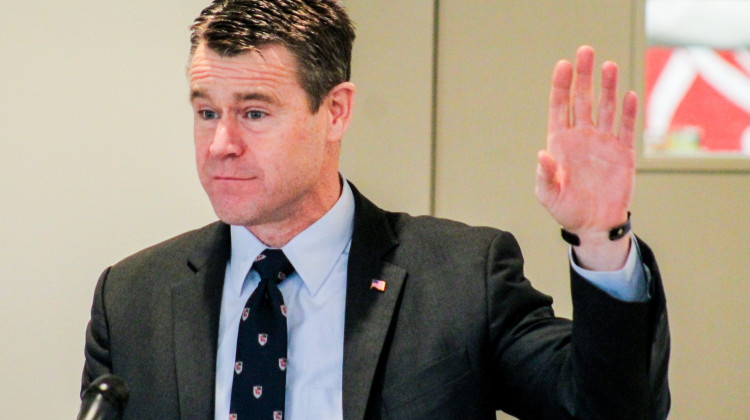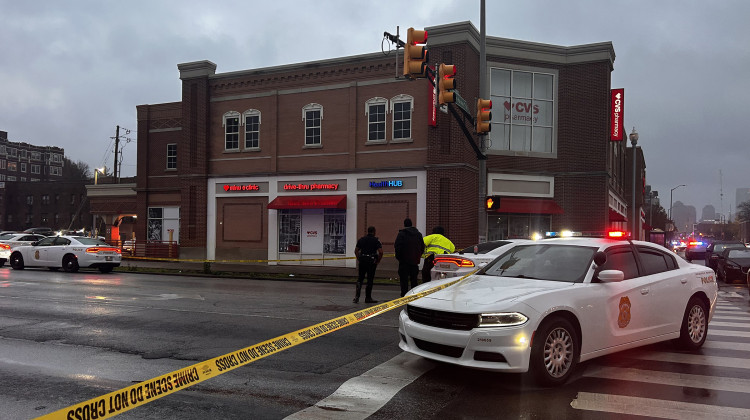
Indianapolis Mayor Joe Hogsett announced a package of infrastructure changes at the Vision Academy. (Jill Sheridan/WFYI)
Indianapolis Mayor Joe Hogsett announced a series of actions that aim to improve neighborhood roadways, pedestrian safety and state funding.
The first move is a planned investestment in residential streets. The 2024 budget will include $25 million to improve streets in many underserved neighborhoods. The Hogsett administration invested that same amount for neighborhood streets as part of the Circle City Initiative. In a speech this week, Hogsett said residential roads are a priority.
“Through this combined effort we can continue the tremendous progress supporting neighborhoods to achieve their transportation needs and their transportation priorities,” Hogsett said.
Another $5 million will go towards alleyway rehabilitation. “To make meaningful progress toward addressing alley needs for residents who have been clamoring for help for years,” Hogsett said.
This safety work builds on the recent announcement of federal money that will help convert roads to two-way and fund new sidewalks and traffic signals. Changing roads to two-way have been shown to reduce vehicle speeds especially in residential areas. Hogsett said the goal is to reduce the rising number of traffic related deaths on roads where drivers typically speed.
“The effects of the pandemic have created a near daily reckoning with a maelstrom of reckless driving,” he said.
A second prong builds on the safety element for pedestrians, bikers and students. The changes include the installation of flashing lights in school crosswalks. The city will also support legislation next year that would permit the use of video cameras to enforce speeding around schools, according to Hogsett.
A proposal that will be introduced to the City-County Council this month gives Park Indy, the city’s parking meter contractor, the authority to ticket and tow vehicles blocking handicap parking spots or bike lanes. Currently the Indianapolis Metropolitan Police Department does that job.
Indianapolis City-County Council Vice President Zach Adamson said this is a job IMPD has not had the capacity to do. “Without the enforcement arm that we lack within our public safety offices parking is a logical choice for that,” Adamson said.
The final piece is an effort to update the state's current road funding formula, which counts road length and not total lanes. Local leaders have long argued that the formula unfairly calculates the funding needed for roads in Indianapolis. Hogsett said the message is getting through to lawmakers.
“The historic state formula falls far short of the kind of long term thinking that Governor Holcomb and leaders in the Indiana General Assembly seek to embrace,” Hogsett said.
The city said it will work closely with a state task force this summer to target an equitable change. A proposed solution would change the formula to count vehicle miles traveled and give Marion County an additional $49 million in annual road funding.
Hogsett said in the past this has been an Indianapolis problem but now other suburban cities are starting to understand the flaws in the state’s road funding formula.
“The struggles of Indianapolis have become the canary in a coal mine for all of our neighbors,” he said. “While our major roads explode each winter, their multi-lane thoroughfares present a ticking time bomb that will go off if significant action is not taken.”
The city estimates the eight counties surrounding Marion County would benefit from an added $47 million if the formula was changed.
Contact WFYI city government and policy reporter Jill Sheridan at jsheridan@wfyi.org. Follow on Twitter: @JillASheridan.
 DONATE
DONATE






 Support WFYI. We can't do it without you.
Support WFYI. We can't do it without you.